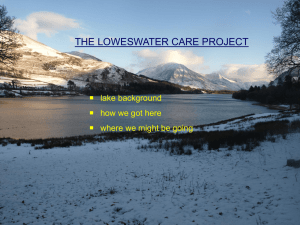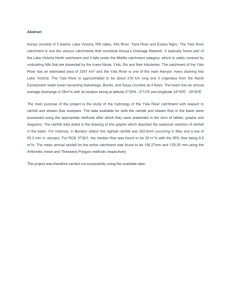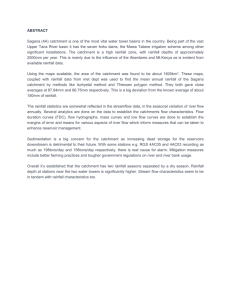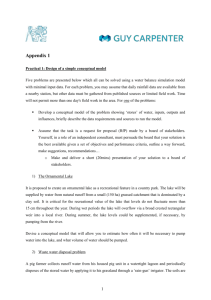Regional Development in Northern Victoria is threatened by Climate
advertisement
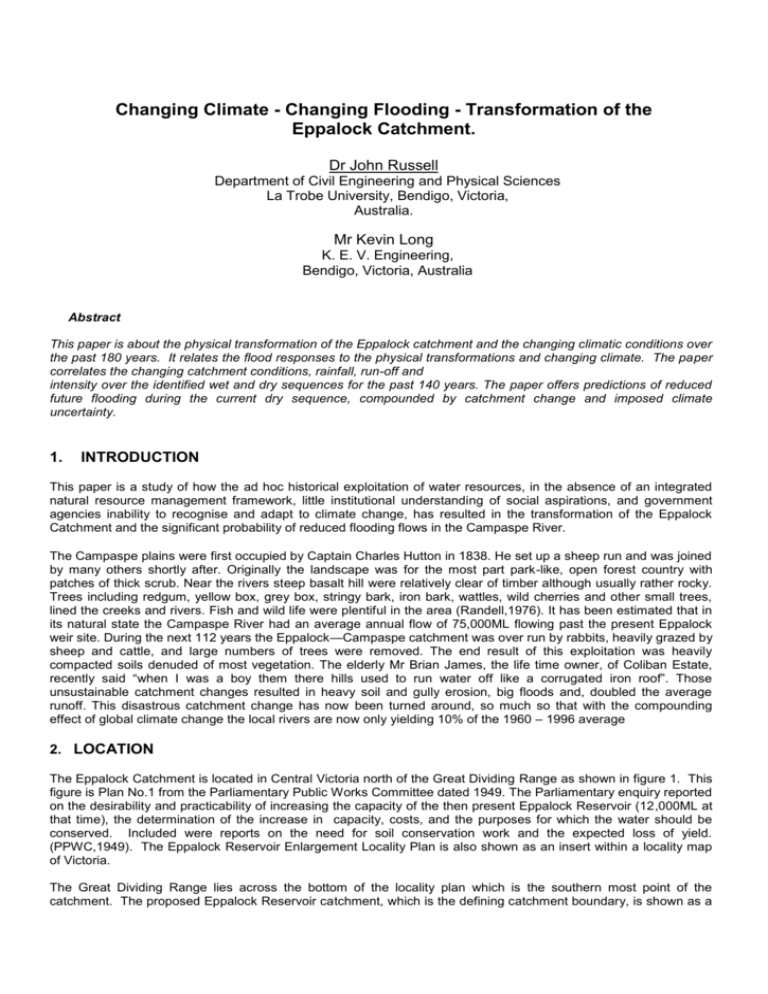
Changing Climate - Changing Flooding - Transformation of the Eppalock Catchment. Dr John Russell Department of Civil Engineering and Physical Sciences La Trobe University, Bendigo, Victoria, Australia. Mr Kevin Long K. E. V. Engineering, Bendigo, Victoria, Australia Abstract This paper is about the physical transformation of the Eppalock catchment and the changing climatic conditions over the past 180 years. It relates the flood responses to the physical transformations and changing climate. The paper correlates the changing catchment conditions, rainfall, run-off and intensity over the identified wet and dry sequences for the past 140 years. The paper offers predictions of reduced future flooding during the current dry sequence, compounded by catchment change and imposed climate uncertainty. 1. INTRODUCTION This paper is a study of how the ad hoc historical exploitation of water resources, in the absence of an integrated natural resource management framework, little institutional understanding of social aspirations, and government agencies inability to recognise and adapt to climate change, has resulted in the transformation of the Eppalock Catchment and the significant probability of reduced flooding flows in the Campaspe River. The Campaspe plains were first occupied by Captain Charles Hutton in 1838. He set up a sheep run and was joined by many others shortly after. Originally the landscape was for the most part park-like, open forest country with patches of thick scrub. Near the rivers steep basalt hill were relatively clear of timber although usually rather rocky. Trees including redgum, yellow box, grey box, stringy bark, iron bark, wattles, wild cherries and other small trees, lined the creeks and rivers. Fish and wild life were plentiful in the area (Randell,1976). It has been estimated that in its natural state the Campaspe River had an average annual flow of 75,000ML flowing past the present Eppalock weir site. During the next 112 years the Eppalock—Campaspe catchment was over run by rabbits, heavily grazed by sheep and cattle, and large numbers of trees were removed. The end result of this exploitation was heavily compacted soils denuded of most vegetation. The elderly Mr Brian James, the life time owner, of Coliban Estate, recently said “when I was a boy them there hills used to run water off like a corrugated iron roof”. Those unsustainable catchment changes resulted in heavy soil and gully erosion, big floods and, doubled the average runoff. This disastrous catchment change has now been turned around, so much so that with the compounding effect of global climate change the local rivers are now only yielding 10% of the 1960 – 1996 average 2. LOCATION The Eppalock Catchment is located in Central Victoria north of the Great Dividing Range as shown in figure 1. This figure is Plan No.1 from the Parliamentary Public Works Committee dated 1949. The Parliamentary enquiry reported on the desirability and practicability of increasing the capacity of the then present Eppalock Reservoir (12,000ML at that time), the determination of the increase in capacity, costs, and the purposes for which the water should be conserved. Included were reports on the need for soil conservation work and the expected loss of yield. (PPWC,1949). The Eppalock Reservoir Enlargement Locality Plan is also shown as an insert within a locality map of Victoria. The Great Dividing Range lies across the bottom of the locality plan which is the southern most point of the catchment. The proposed Eppalock Reservoir catchment, which is the defining catchment boundary, is shown as a 2 strong brown dotted line. In this paper this catchment is referred to as the Coliban and Upper Campaspe Catchments. Downstream of the then proposed site of the Eppalock Reservoir and continuing along the Campaspe River to Echuca is what is termed in this paper the Lower Campaspe Catchment. The three major tributaries flowing into Lake Eppalock are Wild Duck Creek in the east, the Campaspe River flowing centrally from south to north and the Coliban River in the South West. The Coliban Catchment is defined by a small dotted line including three reservoirs, Upper Coliban, Lauriston and Malmsbury. Water from these three reservoirs is diverted by concrete race and open earthen channels to the Coliban System where it is used for irrigation and water supply to a number of towns and cities including Kyneton, Castlemaine and Bendigo. A small quantity of water is released into the Coliban River as environmental flow. Figure 1 – Eppalock Catchment Locality Plan 2 3 Figure 2 – Five Year Rainfall Average Chart with Actual Totals & Actual Flood to Drought Spacing 3. PAST AND PRESENT YIELDS AND FLOODING. The largest flood in recorded history, which produced massive flood levels in the lower Murray, more than 1 metre higher than any other flood, occurred during 1956. This massive flood was produced after 3 above average rainfall years, (673 mm 769 mm 767mm Bendigo rain). The chance of another flood of that magnitude is now much less due to, the enlarging of Lake Eppalock, catchment change and most recently the impact of climate change. The resultant yields have dropped by 90% over the last seven years. During the years 1962 to 1997 the catchment regularly yielded large river flows from the predominantly agricultural farm land. The wettest year on record is 1973 with 1017mm of rain measured at Bendigo, this produced the largest annual inflows to Eppalock, but not as high floods down the Murray as 1956. Since 1973 the peak flows and average flows have progressively declined. The present trends of river flows indicate that possibly a one in 50 year rain event will be needed to produce a flood downstream of Eppalock. The depleted subsoil moisture and improved farming practices in the adjoining areas of the catchment, including the recently fenced and enhanced buffer zones along the rivers and creeks lines, now dominated by weeds including Phalaris and millions of small trees, have turned a flood prone catchment into a dry sponge. 4. TOPOGRAPHY OF THE EPPALOCK CATCHMENT – EFFECT ON YIELD AND FLOODING Most of central Victoria’s weather comes from the southwest, west and north-west direction, however, due to the topography of the region most of these rains yield poorly into the Eppalock catchment. The Great Dividing Range to the south together with the spur running from Trentham to Bendigo provides a barrier to the westerly air flows causing a rain-shadow in the Eppalock Catchment. This rain-shadow effect results in huge variations to the yearly yields. In years pre 1976 the best yielding rains were those s that originated from the north east and corresponded to, the La Nina years. They usually occurred one year in four. However during the last 30 years, the La Nina intensity has shown a progressive and marked decline. None of the last 3 La Nina cycles have delivered above average rain, in this area. 5. METEOROLOGICAL INFLUENCES ON THE INFLOW-FLOODING TO LAKE EPPALOCK 3 4 The El Niño - La Nina is predominately a 4 year climate cycle. This cycle produces large variations in inflows to Lake Eppalock from year to year. In the La Nina years Lake Eppalock normally receives about 65% of its inflow cycle due to the increased rain events predominately from the north east. The remaining 35% is usually produced during the other two average years of the normal climate cycle and, very little inflow is produced from the El Niño year. This El Nino cycle can occasionally span two winters. Typically in a cycle there are two average years, one below average year and one above average year. Those were the pre climate change conditions. 6. CLIMATE CHANGE AND INFLOW-FLOODING HISTORY History indicates that during the first 32 years of European settlement (1788 to 1820), drought conditions were the dominate feature of life on the land, however, it was during the above average seasonal conditions from 1820 to 1875 that Australia developed much of its agriculture and mining industries. A dry period prevailed again from 1880 to 1950 during which time there were five major droughts. For this period the rainfall was 10% below the long-term average. The period 1950 to 1996 was a wet period similar to1820 to 1875. During this period 10% above the average was recorded and 3 major flood periods 1954 to 1956, 1973 to 1975, 1988 to 1992 and two short term droughts 1967 and 1982: Figure 2 depicts Bendigo's five-year average weighted rainfall readings for the last 140 years showing the wet and dry sequence plus related cycles of drought spacing and the spacing between peak rain as well as the drought year events. Future predictions to 2032 are included. The long-term average rainfall for Bendigo was 540 mm but is now declining. (Long, 2004) (Bendigo Advertiser 2003) Last ten year average is the lowest on record, showing only 450 mm. Since 1992 there has been a steady decline in the average long-term rainfall. Drought conditions have dominated since 1997. The last 10 years gave the lowest average rainfall on record. The CSIRO observed that the rainfall had flip-flopped in 1992 from a long-term wet sequence to a dry sequence. (Jones, 1997) Autumn rainfall averages in the Upper Campaspe Catchment have averaged 40% less over the last 14 years, (Burns,2006:3) a similar reduction to the average winter rainfall is now evident. 7. RIVER FLOW CHARACTERISTIC The Campaspe River contributes the major inflow into Lake Eppalock for two reasons. The first is that the other major river, the Coliban River, contributes little to the inflow to the lake during dry years due to the excision of the Upper Coliban Catchment for the supply of the Coliban System of Headworks. (Callinan,1948:4). The second is that the Campaspe River exhibits an extreme variation in flows when compared with other rivers in the state. The ratio of the maximum to minimum flow for the Campaspe, Coliban, Goulburn and Murray Rivers are 916:1, 22:1, 12:1 and 9:1 respectively. (ibid,1948:2). The extreme variability of the flows in the Campaspe River can be seen in the yearly inflows to Lake Eppalock in Figure 3 below. (Goulburn-Murray Water, 2006) The Campaspe River’s inflow to Lake Eppalock for the last 114 years showing the wet and dry sequences are also shown in Figure 3. The 5 and 10 year averages even out the yearly inflows and accentuated the wet and dry sequences. A trend line for the last fourteen years shows how the annual inflow is decreasing. The inflow for 2006, only 1000ML, is shown in red at the extreme right of figure 3. As at 1st September 2007 only 12,000ML had been yielded for 2007. This year’s inflow highlights the spongelike nature of the catchment at present given that, 250 mm of rain over 40 days, (28th April to 4th June this year), produced only a minimal river flow. 4 5 Dry Sequence Wet Sequence 1878 to1952 Dry 1952 to 1996 Decreasing annual inflow Figure 3 – Campaspe Inflow to Lake Eppalock 8. THE ENLARGEMENT OF LAKE EPPALOCK AND IMPACT ON FLOODS 8.1 Determining the Capacity of the Lake Enlargement The Enlargement of Lake Eppalock was considered in a Parliamentary Public Works Committee report dated 1949. (PPWC, 1949) This report considered; the desirability and practicality of increasing the capacity of the existing Eppalock Reservoir from 12,000ML to 250,000 or 350,000ML, the extent to which the capacity could be increased, its associated costs and the purposes for which the water should be conserved. In relation to the above Bernard J. Callinan, Consulting Chartered Engineer, submitted the following evidence, “In the case of the Eppalock project the great variation between maximum and minimum flow makes the annual output small in comparison with the storage capacity, but it has been stated that a storage capacity of 200,000 acre feet has a normal annual output of 64,450 acre feet, or approximately 32% of the storage capacity. This figure can be compared with the proposed enlargement of the Eildon Reservoir which would provide an annual output equal to approximately 65% of the storage capacity”. (Callinan, 1949) From Callinan’s statement above it can be inferred, that the catchment’s yield is very unreliable and requires proportionately a larger storage volume than other reservoirs in Victoria to cater for long periods of low river flows. However, as fate would have it, in the year Lake Eppalock was commissioned it filled and continued to enjoy extravagant inflows for the next 34 years. This led to the false sense of security which is reflected in the recent computer modelling predictions. This system has now failed to deliver any allocation during the last two seasons so far. (As at 20-9-07) 8.2 Land Conservation Measures Extensive clearing of land and agricultural activities particularly during the 1914-18 war caused an onset of serious gulley and farmland erosion. Such erosion was identified in the Public Works Committee’s 1949 Report where the eroded status of the catchment area above Lake Eppalock was acknowledged. Evidence submitted by Mr Thompson, an executive officer from the Soils Conservation Board, stated, "... that the rate of erosion is on the increase, and recommended that positive action in a way of soil conservation practices should be taken to stop it, not only because of the effect upon the proposed reservoir, but in order to preserve and improve the soil." (P P W. 5 6 C., 1949: 9). Further evidence submitted by Bernard J. Callinan vigorously supported the above and stated that in his opinion the essential land conservation measures would reduce the projected yield from 80,000 to 70,000 ML/year. He further claimed that allocations needed to be conservative until the effects of conservation measures were known. (Callinan,1949) Further, in 2006 the State government made $1 million available for the fencing of the Coliban River in the upper catchment with the intention of improving water quality, revegetating buffer zones and increasing biodiversity. The authors contend that these major works in the Coliban River are current examples of the ad hoc well intentioned but uncoordinated environmental investment in the Upper Eppalock Catchment which will further reduce the total inflows to Lake Eppalock especially during critically dry years. During the last two years only 3% of the long term average has been yielded. 9. CATCHMENT YIELDS AND FLOODING 9.1 Past and Present Catchment Inflows to Lake Eppalock Based on river flow records of the previous dry sequence “pre-Lake Eppalock”, Lake Eppalock was expected to have an average inflow of 153,000 ML per year. This is in stark contrast to the actual inflow into Lake Eppalock. During the recent wet sequence Eppalock averaged 206,000 ML inflow for the period 1962 to 1997. This is in further contrast to the last 7 years (dry sequence) where the inflow has averaged only 22,000 ML per year. An indication of the past catchment performance has been attained by the study of the rainfall records at Metcalfe over the period of the recent wet and the present dry sequence. Metcalfe is located approximately in the centre of the Upper Campaspe Catchment and offers a continuous rainfall record from 1900 to the present day. (Mactier, 2007). . Period Average Yearly Rainfall at Metcalfe Average Effective Rainfall (runoff) Across Catchment Average Inflow to Lake Eppalock ML/Year Average % of Inflow to Lake Eppalock/year Dry Sequence 1878 to 1951 626 mm (1900 to 1952) 50 mm Pre-Eppalock 153,000 Campaspe river flow Pre-Eppalock 50% Per-Eppalock Wet Sequence 1952 to 1996 680 mm 66 mm 206,000 (Eppalock Inflow 1962 to 1996) 66% Dry Sequence 1997 to 2006 560 mm 21 mm 65,000 21% 2001 to 2007 526 mm 6mm 22,000 6% Table 1 - A Summary of the Relationship Between the Average Yearly Rainfall at Metcalfe and Inflow into Lake Eppalock. (Now reducing at a rapid rate). From Table 1 above it can be seen that during the wet sequence the average effective rainfall, (runoff), across the catchment, was 66 mm per year which corresponds to an average inflow to Lake Eppalock of 206,000 ML/year, a very large inflow. From this it can be seen that small reductions in average yearly rainfall, compounded by land care practices, has resulted in significant reductions in inflow to Lake Eppalock. Alternatively the increased water retention, due to Landcare practices, during the wet sequence had little effect when there were large inflows, however, during the dry sequence increased consumption of water due to land care practices has had a major effect on the inflow potential. i.e. Landcare practices on average retain 11mm of effective runoff, this equates to the major share of the rainfall now available, leaving only 6mm per year on average to provide for all downstream users. 6 7 9.2 Factors Influencing Catchment Yield 9.2.1 Landcare The Landcare movement commenced in Victoria in 1986. It started with a number of small groups of independent neighbours, mostly in the rural areas, working together on local issues to enhance the local environment and give benefit to the local community. Much of Landcare's initial effort resulted in the increase of local biomass and biodiversity. The movement was given support firstly by the State government and later by both the Federal and State governments, through the Natural Heritage Trusts (NHT I & 2) and the National Action Plan (NAP). Landcare projects have generally remained small, focussed on local issues and are to a large extent not explicitly integrated into catchment planning or natural resource management. Landcare participants are actively intertwined with the following factors which influence catchment yield. A number of catchment transforming activities in the Upper Eppalock Catchment, including Landcare activities, are listed below. 9.2.2 New Consciousness in Farming Practices Present-day farmers utilize their land much better than the farmer of pre-1950s. They use new perennial grasses such as phalaris, and, in recent years, improved techniques such as contour plowing and soil aeration. These improved farming and land care practices enhance the capacity of the catchment’s soil to retain water. In addition to the above, the catchment now carries less stock, has an increased number of small dams, supports the growing of millions of new small trees and sustains the established trees. The end result is that except in above average rainfall years very little water flows off these farms. The widespread adoption of Landcare attitudes, techniques and practices has exacerbated the loss of yield throughout the catchments during this time of both global warming and natural drought. 9.2.3 Effects of Calicivirus – reduced Rabbit impact. In October 1996 the Calicivirus, (biological rabbit control), escaped from a government experimental trial and quickly reduced the rabbit numbers in the Eppalock catchment. This reduction in rabbit numbers has enhanced the past efforts of the Department of Sustainability and Environment, the North Central Catchment Management Authority and Landcare groups who encouraged the fencing off of buffer zones along the gullies, creeks and rivers throughout the catchment. Without the rabbit’s presence the regeneration of vegetation along these buffer zones has been remarkable. The rabbit’s absence has resulted in improved water quality, but also significantly less runoff to Lake Eppalock, due to the demand placed on soil moisture by the millions of small gum trees now able to germinate and grow in the catchment. Over the last seven years (2001 to 2007) the average inflow into Lake Eppalock has been only 22,000 ML per year. This equates to a 90% loss of yield, and the average is still declining. Much of this recent loss can be attributed to the removal of rabbits from the catchment. This now means that large amounts of last season’s vegetation is left standing in and along most of the creeks and rivers slowing the water flow thus there is more time for water to seep into the catchment’s soil. This is effectively adding another “reservoir” to the system which will also reduce the chances of future flooding. 9.2.4 Land subdivision and Life-style Farming In recent years many subdivisions have been developed throughout the catchment and a great number of life-style farmers have taken up residence. These life-style farmers generally do not work the land in the traditional manner, usually they have fewer life stock and they re-vegetate the land with native trees and introduced species of grasses. These practices, together with the digging of many small dams, have contributed to the reduction of yield from this catchment. The Department of Sustainability and Environment have reported in recent years that the estimated capacity of the small dams is 40,000 ML in total. This means the, “sustainable diversion limited”, has been contravened by 400%. During the last 14 years the yield has steadily reduced due to the increased harvesting of the fallen rain. This now means Lake Eppalock will be near to empty at the beginning of most winters. Past records indicate it will take several consecutive wet years to produce a flood downstream of the now predominately empty Lake Eppalock. 7 8 9.2.5 Reducing Catchment Yield The drastic decrease of inflow into Lake Eppalock due to the factors affecting catchment runoff and climate change is shown graphically in a figure below. The outlook for inflow as at the 1st of September 2007 is dire with little reservoir rise to date and a drying catchment. Goulburn-Murray Water has announced a zero entitlement for the coming irrigation season once again.(this will be amended if the situation changes) and Coliban Water has stated that if significant rainfall does not occur Bendigo will continue to be on harsh restrictions and there will be little water for the irrigation again this season. Figure 4 Eppalock Inflow Actual May 2000 to October 2005 and Average Inflow Envelope 1962 – 1996 Only 12,000ML inflow for 2007 to 1stSeptember Only 1000ML inflow during 2006 not much more was recorded in 1997/ 2001/ 2002 10 out of the last 11 years have averaged only 25,000ML 9.2.6 Reasons for Reduced Catchment Yield Lake Eppalock was built with the expectation that the average inflow would be in the order of,152,000 ML/year (assessed from records taken during the dry period 1878 to 1952). The authors conclude that a comparable present day inflow, further reduced by the impact of global warming would be of the order of 60,000 ML/year. This figure further reduces with the increased numbers of farm dams and vegetation changes. (Landcare principles at work). Consequently the average inflow into Lake Eppalock over the last 7 years has been only 22,000 ML/year. It can be extrapolated that the 38,000 ML/year loss of inflow is attributed to Land care practices in the catchment. These Land care practices have in effect shifted, on average, 38,000 ML/year of water from the Campaspe Irrigation Area in the Lower Catchment to the Upper Catchment. This water has been consumed by; the improved pastures, increased number of small dams and increased revegetation in the Upper Catchment. This loss has a huge impact especially during the dry periods. (Russel and Long, 2006) 10. SUBSOIL MOISTURE DEFICIT During the last 14 years there has been approximately 40% less Autumn rainfall, (attributed by the authors to the intense global warming in the northern hemisphere), The subsequent reduced rainfall intensity, a lower average rainfall overall and an increased vegetation demand on the soil moisture. Quantification of the soil moisture loss for the catchment is difficult to assess; however, the authors calculate that between 1993 and 2007 the total equivalent rainfall reduction is approximately 1.6 meters when compared with the average rainfall of the previous 44 years (1962 to 1996). During this period the subsoil was saturated to the surface for many months of most years. 8 9 Further, it is estimated that the soils now need 700 mm of soil moisture to return to the levels similar to that of past years. It is the view of the authors that this will take many years of above average rainfall and that with the current trends; it could be 60 years before the subsoil moisture deficit is fully met. 11. PAST PRESENT AND PREDICTED INFLOWS-FLOODING INTO LAKE EPPALOCK AND ATTENUATED FLOODING POTENTIAL The past, present and predicted inflows to Lake Eppalock are shown in table 2 below. The future demand on water supplied from the Eppalock Catchment is expected to increase due to increased population and demand from towns and cities in the region. Based on the hypothesis that our climate has entered a dry sequence, the predicted inflow into Lake Eppalock for the period spanning from 1997 to 2070 is optimistically only 60,000 ML per year an inflow that is 38,000 ML per year above what the current short-term yield has been. (Last 7 years averaged only 22,000ML and still reducing). It is expected the combination of global warming, re-vegetation, Landcare activities and improved farming practises will further reduce the potential runoff from the Upper Campaspe Catchment and result in the future long term average being much reduced compared to past records. Period Past Dry Period 1878–1952 Past Wet Period 1952 – 1996 Average Annual Inflow 153,000 ML/year 206,000 ML/year Present Dry Period 2001–2007 Last 7 years 22,000 ML/year Predicted Dry Period 1997–2070 Prediction 60,000 ML/year (Optimistically) Table 2 - Past Present and Predicted Inflows/Flooding into Lake Eppalock 12. AN EXAMPLE OF REDUCED FLOODING EVENTS IN TODAYS EPPALOCK CATCHMENT The recent rains that commenced in late April this year produced 250mm in 40 days and resulted in 1,000 ML inflow to Lake Eppalock. A similar three week rain in October-November 2000 resulted in 250,000 ML. This is a stark example illustrating the impact of both catchment and climate change in this region. 13. CONCLUSIONS It is concluded that; 1. The historical records of rainfall show that there are identifiable sequences of wet and dry periods and that these sequences have increased or decreased the yields of the Campaspe River for long periods. 2. Inflows and flooding into Lake Eppalock are not only influenced by the wet and dry sequences but are significantly reduced by the Landcare activities, improved farming practices and other factors in the catchment. 3. The ad hoc historical exploitation of water resources, the absence of an integrated natural resource management framework in the catchment, little institutional understanding of social aspirations and government agencies inability to recognise and adapt to climatic change has resulted in a catchment that significantly attenuates flooding. 4. The future direction for Landcare and the government agencies should be to integrate the management of the natural resources in the Eppalock Catchment so as to enhance the natural resources, while simultaneously maintaining the inflows to Lake Eppalock and to be aware of the attenuation of flooding in the catchment. 5. Most catchments in Victoria are in a state of transformation due to both catchment and climate change. 6. Possible impacts of climate change...less rain but more intense storm events...higher evaporation. 9 10 14. ACKNOWLEDGEMENTS Bendigo Advertiser for publishing the Bendigo Rainfall Chart 1863 to 2002 Mr Frank Hill, for access to his historical documents. Mr Hill is a lifetime resident and past councillor of Heathcote and lives on the eastern shore of Lake Eppalock. Mrs Evelyn Mactier for access to her personal rainfall records for Metcalfe. Coliban Water, Goulburn-Murray Water and the Eppalock Action Group for the provision of information. The La Trobe University Bendigo for making this paper possible. Mr. Brian James, Coliban Estate. 15. REFERENCES Bendigo Advertiser (2003) Bendigo Rainfall Chart 1863 to 2002 Bendigo Advertiser Friday, January 31 Friday 2003 Burns, C. (2006) Farm Dam Research in the Campaspe Catchment Fact or Fiction Lake Eppalock Action Group June 2006 Callinan, B. (1948) Evidence Submitted to the Parliamentary Public Works Committee on Wednesday, the 20th of October, 1948 CGB (2003) Drought Impact Report - 2003 - Lake Eppalock (2003) City of Greater Bendigo Goulburn-Murray Water (2006) Draft Fact Sheet Number 1 for the Campaspe System Water Resource Management, Campaspe System Hydrology. Goulburn-Murray Water. Tatura Goulburn-Murray Water (2005) Communication between G-MW officers and Mr Kevin Long Jones, R. (1997) Climatic Change Seminar (1997) La Trobe University, Bendigo, Victoria. Long, K. (2004) Notes of Statistical Studies of Rainfall at Bendigo and Inflows into Lake Eppalock Matcier, E. (2006) Personal Rainfall Records, "North Lodge” Metcalfe, Victoria. 1949) The Parliamentary Public Works Report (1949) Parliament House Melbourne, Victoria. Randell, J (1976) Published Queensberry Hill Press Russel, J and Long K (2006) A Failed Lake Eppalock: a dire indicator for a parched Murray Darling Basin. 10


